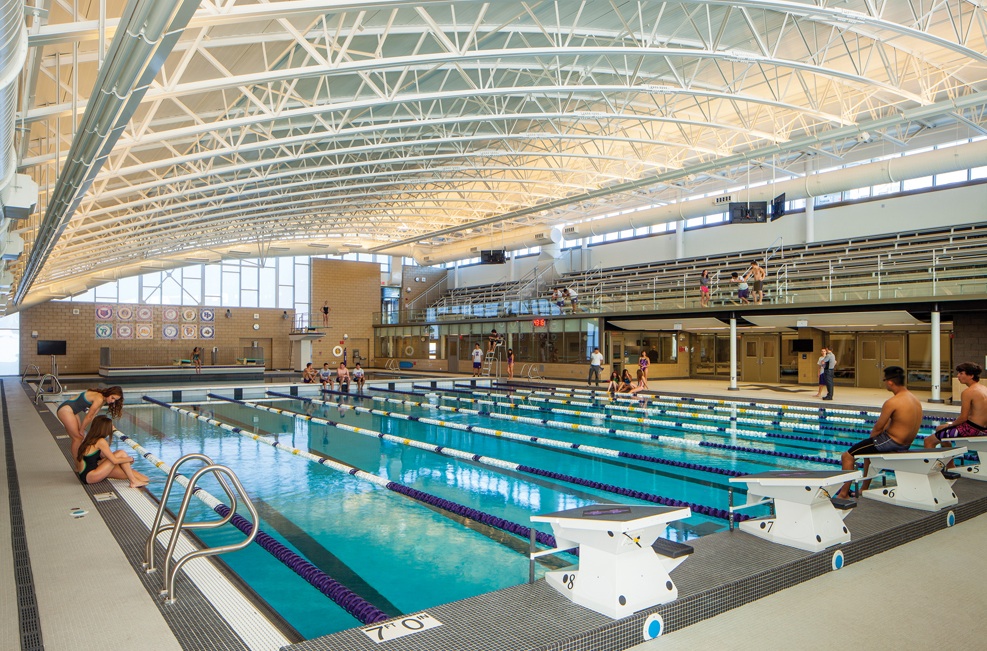The Building Team for the new Aquatics Center at Niles North High School in Skokie, Ill., included Chicago-area firms Legat Architects and IHC Construction—but a case could be made for listing a much larger group of official participants. The AEC firms made a concerted effort to involve not only district officials but also the user community. As a result, the project became a unique learning experience for students, staff, and neighbors.
The Niles North Aquatics Center serves 2,200 students—all of whom must take swimming—as well as 275 competitive student athletes in swimming, diving, and water polo. Feeder programs from park districts and local partners are also housed there. By 2012, the pool in the 48-year-old building was considered too small and shallow to meet current requirements.
Stakeholders asked for a new competition “cold pool,” a renovated community-accessible “warm pool,” a new public connecting corridor, locker room renovations, coaches’ offices, and meeting and storage space. Lighting and mechanical systems also needed an energy upgrade.
SILVER AWARD
Project summaryNiles North High School Aquatics Center
Skokie, Ill.BUILDING TEAM
Submitting firm: Legat Architects (architect)
Owner/developer: Niles Township High School District 219
Structural: KJWW Engineering Consultants
Mechanical/plumbing: AMSCO Engineering
Electrical: Hansen Palmer Associates
Civil: Gewalt Hamilton
CM: IHC Construction CompaniesGENERAL INFORMATION
Project size: 39,200 sf (24,600 sf new + 14,600 sf renovated)
Construction cost: $15 million
Construction period: April 2012 to August 2013
Delivery method: Design-bid-build
District 219 teamed with Legat Architects to plan the revitalization. Students and community members were surveyed regarding their priorities, and the Building Team held design workshops that elicited feedback for the floor plan. Daylighting is an important aspect of the final design, including a mix of clerestories, clear windows, translucent windows, and internal glazing to offer glare-free illumination and visual connections.
Eventually, the project was incorporated into the district’s architecture and engineering class curriculum. Biweekly tours were coordinated with faculty to focus on current classroom topics, and students were able to receive insights on various career paths.
“It became quite the living classroom,” says Building Team Awards judge Nathan Snydacker, PE, LEED AP, Vice President at Environmental Systems Design.
“It’s a lot of involvement you’d want in a school project of this type,” adds BTA judge Terry Fielden, LEED AP BD+C, Director of K-12 Education for International Contractors.
The Building Team phased construction over two summers to minimize disruption, keeping the community involved with a blog, video tours, signage with QR codes, and outreach to local news outlets.
In spring 2013, a severe flood created leaks in the lower-level filtration room. The damage stalled excavation and construction of the pool slab and walls, but IHC Construction, Legat, D219 staff, and other contractors managed to keep the job on schedule and within budget.
The result is a more functional, accessible, energy-efficient facility, designed to use 42% less water and 44% less energy than typical natatoriums. The project, whose heat-recovery dehumidification units should also sharply reduce CO2 emissions, is expected to become the first aquatic center in Illinois to achieve LEED for Schools Gold certification.
Related Stories
| Oct 6, 2010
Windows Keep Green Goals in View
The DOE's National Renewable Energy Laboratory has almost 600 window openings, and yet it's targeting LEED Platinum, net-zero energy use, and 50% improvement over ASHRAE 90.1. How the window ‘problem’ is part of the solution.
| Oct 6, 2010
From grocery store to culinary school
A former West Philadelphia supermarket is moving up the food chain, transitioning from grocery store to the Center for Culinary Enterprise, a business culinary training school.
| Sep 30, 2010
Luxury hotels lead industry in green accommodations
Results from the American Hotel & Lodging Association’s 2010 Lodging Survey showed that luxury and upper-upscale hotels are most likely to feature green amenities and earn green certifications. Results were tallied from 8,800 respondents, for a very respectable 18% response rate. Questions focused on 14 green-related categories, including allergy-free rooms, water-saving programs, energy management systems, recycling programs, green certification, and green renovation.
| Sep 22, 2010
Michael Van Valkenburg Assoc. wins St. Louis Gateway Arch design competition
Landscape architect Michael Van Valkenburgh and a multidisciplinary team of experts in “urban renewal, preservation, commemoration, social connections and ecological restoration” have been picked for the planning phase of The City+The Arch+The River 2015 International Design Competition.
| Sep 22, 2010
Satellier, Potential + Semac close investment deal
Satellier, a world leader in providing CAD and Building Information Modeling (BIM) outsourced services to the architecture, engineering and construction industry, announces a strategic minority investment from India-based top engineering firm Potential + Semac, ushering in the next evolution of the global architecture support industry.









